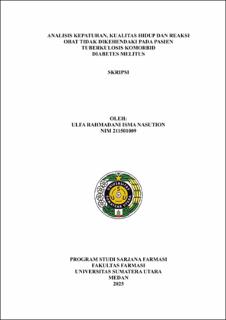| dc.description.abstract | Background: Tuberculosis (TB) and Diabetes Mellitus (DM) are often found together, DM increases the risk of TB and worsens its treatment.
Objective: Find out if there is a difference between patient characteristics and quality of life, the relationship between adherence and quality of life, the impact of adverse drug reactions (ROTD) on quality of life, and the association between adherence and ROTD.
Method: This quantitative study used a cross-sectional design at the TB DOTS Polyclinic of Prof. Dr. Chairuddin P. Lubis Teaching Hospital, Universitas Sumatera Utara, from September to November 2024. Data were obtained from questionnaires and medical records, analyzed using descriptive and inferential tests.
Results: Of 52 patients, 69.2% were male, and 48.1% (25 patients) were aged 54- 71 years, with a mean age of 54.63±15.33 years. High school education was the most common (50%), and 25% were self-employed. DM duration ≤5 years was found in 59.6%, and 63.5% were in the TB intensive phase. Medication adherence was high (94.2%), and 80.8% had a very good quality of life. ROTD occurred in 96.2% of patients. No significant difference was found between patient characteristics and quality of life (p > 0.05). A moderate correlation existed between adherence and quality of life (r = 0.398), while ROTD had a very weak correlation with both quality of life (r = -0.032) and adherence (r = -0.100).
Conclusion: Adherence moderately influences quality of life, while ROTD has minimal impact. No significant differences were observed in patient characteristics and quality of life.
Keywords: Tuberculosis, diabetes mellitus, adherence, quality of life, adverse drug reactions. | en_US |


